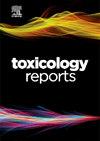Perspective on health and ecological risk assessments of potentially toxic metal(loid)s using aquatic biodiversity as biomonitoring indicators
Q1 Environmental Science
引用次数: 0
Abstract
The presence of potentially toxic metal(loid)s in the environment is a global concern due to their hazards to humans and ecosystems. This review examines the sources, impacts, and human health and ecological risk assessment of potentially toxic metal(loid)s, focusing on the role of aquatic biodiversity as biomonitoring indicators. Using specific keywords, peer-reviewed studies spanning 2000–2024 were mined and reviewed to identify the trends of potentially toxic metal(loid)s in the marine environment and their resultant human health risks. Accordingly, findings indicated that potentially toxic metal(loid)s found their way into water bodies primarily via mining and smelting, industrial discharge, agricultural practices, stormwater runoff, and indiscriminate waste disposal. In the marine environment, this menace leads to bioaccumulation in aquatic biodiversity, disruption of food chains, reduced or loss of biodiversity, degradation of water quality, and behavioral changes in biodiversity. Through food chain transfer, humans are exposed to health risks such as increased cancer risk, kidney and liver damage, gastrointestinal distress, neurological damage, cardiovascular diseases, bone weakness, and reproductive and developmental defects. The review also revealed a strong correlation between aquatic organisms- like fish, bivalves, invertebrates, and macrophytes- and the accumulation of metal(loid). This highlights their valuable roles in long-term pollution monitoring and their potential as early warning indicators. Applying real-time measurements of concentration levels and associated risks offers a revolutionary approach to ecological and human health risk assessments of potentially toxic metal(loid)s. This will permit the optimal use of predictive modeling, accurate and effective monitoring, and early interventions to guarantee sustainability and prevent environmental and public health. The findings of this study hold great promise for improving the sustainability of ecosystems and human populations.
以水生生物多样性为生物监测指标的潜在有毒金属健康与生态风险评估展望
由于对人类和生态系统的危害,环境中潜在有毒金属的存在是一个全球关注的问题。本文综述了潜在有毒金属的来源、影响、人类健康和生态风险评估,重点介绍了水生生物多样性作为生物监测指标的作用。使用特定的关键词,对2000年至2024年期间的同行评议研究进行了挖掘和审查,以确定海洋环境中潜在有毒金属(样物质)的趋势及其由此产生的人类健康风险。因此,研究结果表明,潜在有毒金属主要通过采矿和冶炼、工业排放、农业实践、雨水径流和不加区分的废物处理进入水体。在海洋环境中,这种威胁导致水生生物多样性的生物积累、食物链的破坏、生物多样性的减少或丧失、水质的退化以及生物多样性的行为变化。通过食物链转移,人类面临健康风险,如癌症风险增加、肾脏和肝脏损伤、胃肠道不适、神经损伤、心血管疾病、骨骼虚弱以及生殖和发育缺陷。该综述还揭示了水生生物(如鱼类、双壳类动物、无脊椎动物和大型植物)与金属(loid)积累之间的密切相关性。这突出了它们在长期污染监测方面的宝贵作用及其作为早期预警指标的潜力。应用浓度水平和相关风险的实时测量,为潜在有毒金属(类金属)的生态和人类健康风险评估提供了一种革命性的方法。这将使预测模型的最佳使用、准确有效的监测和早期干预成为可能,以保证可持续性并防止环境和公共健康。这项研究的发现为改善生态系统和人口的可持续性带来了巨大的希望。
本文章由计算机程序翻译,如有差异,请以英文原文为准。
求助全文
约1分钟内获得全文
求助全文
来源期刊

Toxicology Reports
Environmental Science-Health, Toxicology and Mutagenesis
CiteScore
7.60
自引率
0.00%
发文量
228
审稿时长
11 weeks
 求助内容:
求助内容: 应助结果提醒方式:
应助结果提醒方式:


